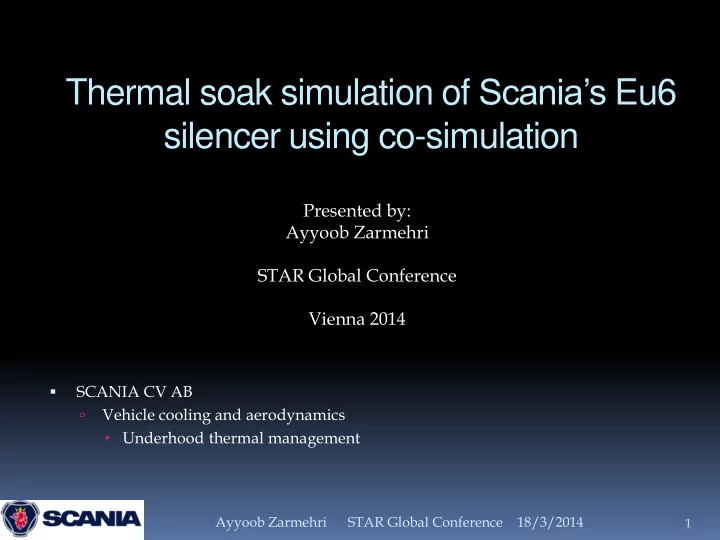

Thermal soak simulation of Scania’s Eu6 silencer using co-simulation Presented by: Ayyoob Zarmehri STAR Global Conference Vienna 2014 SCANIA CV AB Vehicle cooling and aerodynamics Underhood thermal management Ayyoob Zarmehri STAR Global Conference 18/3/2014 1
Underhood thermal management 5 CFD engineers Technical advices for different design and test groups Full truck simulation : All external surfaces of different parts Heat exchangers like radiator, charge air cooler Fan installation Conjugate heat transfer for parts of interest if needed Ayyoob Zarmehri STAR Global Conference 18/3/2014 2
Silencer function Sound absorber Lowering emission level, satisfying Eu6 standard: Inside needs to be hot enough for the chemical factory to function properly Requirements regarding the temperature of the external surfaces Heat sensitive sensors Heat management is necessary to handle the situation Ayyoob Zarmehri STAR Global Conference 18/3/2014 3
The structure of the silencer Polyhedral mesher Embeded Thin mesher 35 million cells mesh Ayyoob Zarmehri STAR Global Conference 18/3/2014 4
The thermal soak process Both the energy source and the cooling airflow are off Inherently transient process Complex function of heat conduction, natural convection and radiation Difficult to test experimentally Need to know the correct amount of energy stored in the system The interaction between the external flow and the system needs to be known One steady-state simulation is needed for the initial conditions Ayyoob Zarmehri STAR Global Conference 18/3/2014 5
The steady-state co-simulation Heat transfer coefficient and the reference temperature is exported Temperature is exported to the UTM simulation Simulation 1: Simulation 2: Internal flow The external flow Heat conduction within Solid Truck speed: 30 km/h structure Steady-state Steady-state Radiation included Ayyoob Zarmehri STAR Global Conference 18/3/2014 6
The natural convection simulation Test cases: flat plate of constant temperature in room temperature Case 1: horizontal plate with upper side heated Case 2: horizontal plate with lower side heated Case 3: vertical plate Physics modeling: density as a polynomial function of temperature Coupled solver Different turbulence models were tested: Standard K-E Low-Re: quadratic constitutive relation thermal stratification for buoyancy production of dissipation K-E two layer buoyancy driven formulation Best results for a wide range of temperature difference : Standard K-E Low-Re Ayyoob Zarmehri STAR Global Conference 18/3/2014 7
Test cases: flat plate in different orientations The natural convection simulation The near wall mesh Vertical plate Horizontal plate, velocity Horizontal plate, wall Y+ Ayyoob Zarmehri STAR Global Conference 18/3/2014 8
The natural convection simulation Experimental values for: Flat plate with dimensions of 0.6m × 0.6m Ambient temperature: 30 °C Ayyoob Zarmehri STAR Global Conference 18/3/2014 9
The thermal soak simulation Solid simulation: Leading simulation Unsteady Time step: 5 s Coupling time step: 150 s Radiation included Fluid simulation: Lagging simulation Initial conditions calculated Steady-state Iterations per exchange: 200 Exports: Specified Y+ HTC and Reference Temperature Ayyoob Zarmehri STAR Global Conference 18/3/2014 10
Conclusions: Thermal soak simulation has been successfully accomplished with co- simulation Transient cooling of the solid mass is coupled to quasi-steady state changes of the external natural convection flow Co-simulation provides an easy-to-use communication method between two different simulations Future works: Urea spray simulation Calibration with experimental results Ayyoob Zarmehri STAR Global Conference 18/3/2014 11
Thanks for the attention! Questions? Ayyoob Zarmehri STAR Global Conference 18/3/2014 12
Recommend
More recommend